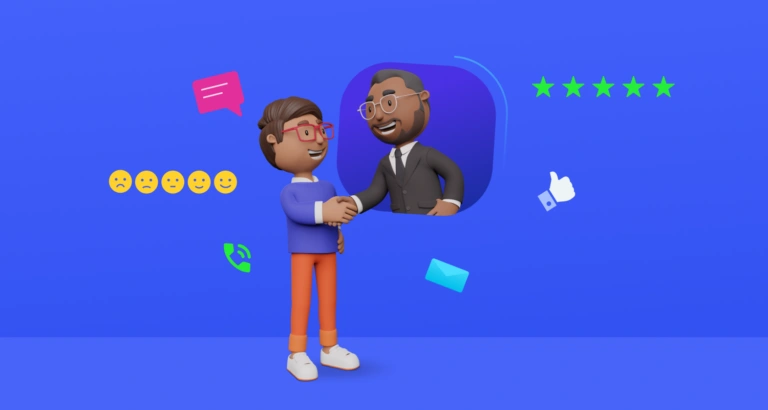For modern organizations to succeed, customer service is essential. However, not every day in the office is smooth sailing. We frequently deal with a wide range of clients that have different comprehension levels. One needs to incorporate empathy in customer service if they want to succeed in this sector.
According to McKinsey, excellent customer experience can boost sales revenue by 2-7% and enhance profitability by 1-2%. Thus, implementing empathy in your help desk can solve customer issues.
Let’s learn more about empathy in customer service by looking through the essential tips and their importance.
What is empathy in customer service?
Empathy is being in someone’s shoes and understanding their feelings and emotions. Empathy in customer service, is the act of directly reaching out to customers who have complaints or issues. It’s an act of encouraging them, promising to fix their problems, or having a final solution to their issue.
Why is empathy important in customer service?
Empathy plays a crucial role in developing and improving a company’s customer service. With an empathetic customer service, a company can get over customer churn and improve customer retention.
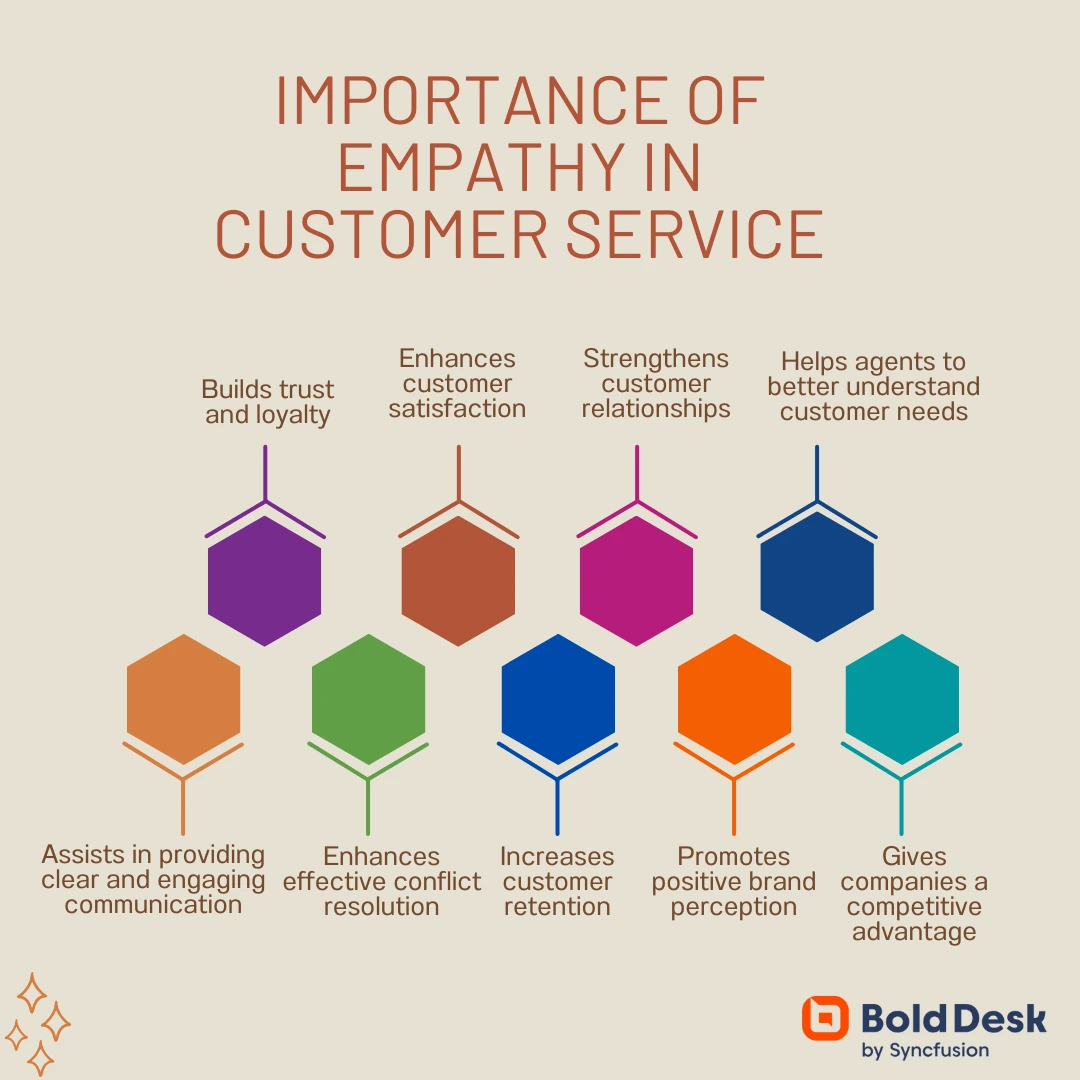
Builds trust and loyalty
Empathetic steps like using emotional validation strengthens and builds trust in customer service. When customers believe that their needs and feelings are understood, they are more likely to trust the company.
Once a customer gains your trust, it is easy to have their loyalty. Customers are more inclined to make repeat purchases and refer the company to others when they feel trusted and loyal.
Enhances customer satisfaction
Empathy in customer service is essential for customer satisfaction, as it helps customers feel valued. For instance, when a customer service representative demonstrates customer service empathy through reassurance, it can turn a negative experience into a positive one.
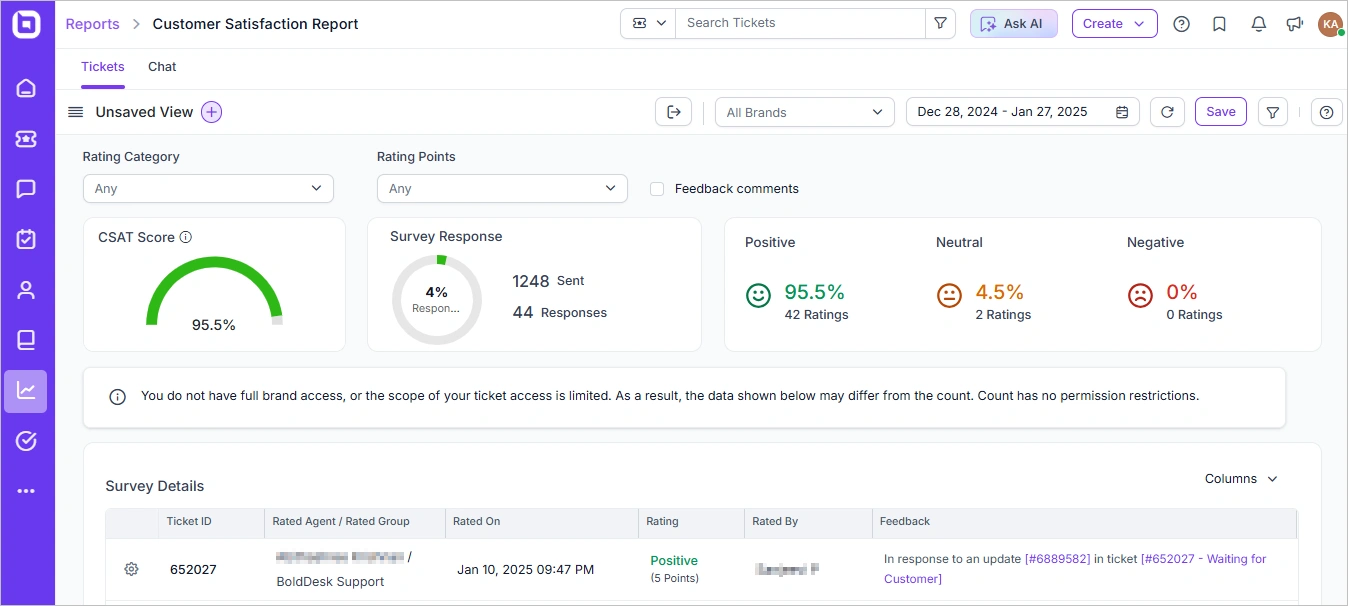
As a result, it can reduce stress and foster a favourable impression that makes the client happy.
Strengthens customer relationships
Empathetic steps like using positive language plays an integral role in nurturing and strengthening customer relationships.
For instance, an agent who uses positive language while communicating to a frustrated customer can provide more personalized and effective solutions. As a result, their bond with clients will improve.
Helps agents to better understand customer needs
An empathetic act like actively listening and showing genuine concern for what clients prefer or need gives agents a second thought on being deeply rooted in customers’ needs.
This makes it easy to determine the root cause of a customer’s problem and provide the most appropriate solution.
Assists in providing clear and engaging communication
Empathetic steps, like patience and being in customers’ shoes, enhance communication in customer service interactions.

With these empathetic steps facilitating better communication, representatives can articulate themselves clearly and offer relevant information, leading to successful customer interactions and fewer misunderstandings.
Enhances effective conflict resolution
Empathy in customer service is essential for effective conflict resolution. For example, an agent can better comprehend a customer’s frustrations and anxieties when he puts himself in the customer’s position.
As a result, knowing how a consumer feels might yield insightful information that can inspire creative solutions that reduce customer pain points.
Increases customer retention
Empathy through personalized customer service is a key factor in building an emotional connection and retention between the customer and the company.
Therefore, by prioritizing empathy in customer service, companies can minimize customer churn and maintain a loyal customer base.
Promotes positive brand perception
Empathy in customer service is closely associated with customer satisfaction score, which reflects brand perception and brand reputation.
Empathetic steps like humane customer service shapes a company’s overall reputation and influences how customers view its products or services.
Gives companies a competitive advantage
Empathetic steps like personalized customer service can provide a marketing gain in today’s competitive business landscape, as it sets the stage for exceptional customer experiences.
Companies that prioritize empathy gain a reputation for superior customer service, leading to a sustainable market.
How to practice customer service empathy
By incorporating empathetic steps into your customer service approach, you can foster strong customer relationships built on empathy, trust, and satisfaction.
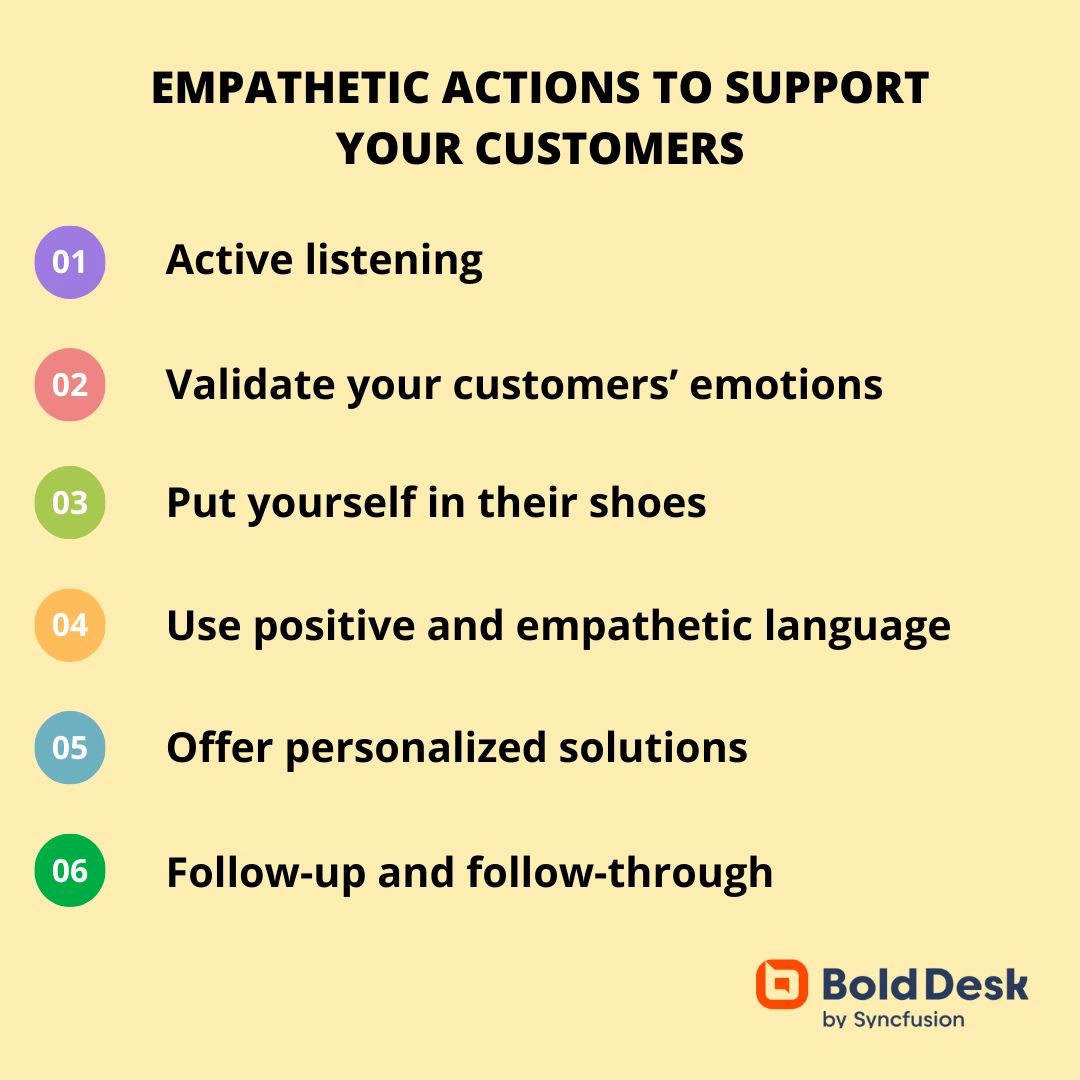
Let’s get into the details of empathetic actions to take:
Active listening
Active listening entails giving the customer uncompromising attention as they communicate what they want, while listening to the words, vocal tone, and emotions behind them. Representatives should avoid interrupting and try to understand the customer’s perspective fully.
By practicing active listening, customer service professionals demonstrate empathy and create a safe space for consumers to express themselves.
Validate your customers’ emotions
Validating a customer’s emotions is an essential step in empathetic customer service. It involves acknowledging and empathizing with the customer’s feelings, even if their concerns seem small or inconsistent.
Validating emotions can be as easy as saying, “I understand that this situation is frustrating for you.” This step helps customers feel heard and understood, building trust and rapport.
Put yourself in their shoes
Empathetic customer service representatives strive to understand a client’s experience by putting themselves in the customer’s shoes. This step requires imagining the customer’s circumstances, challenges, and emotions.
By adopting a customer’s perspective, representatives can customize their responses and solutions to address the particular needs and concerns of the customer, showcasing empathy.
According to Salesforce Research, 76% of customers expect companies to understand their needs and expectations. Sometimes this can only be done through empathy.
Use positive and empathetic language
The choice of language can significantly impact customer service interactions. Empathetic customer service professionals use a language and tone that conveys understanding, compassion, and support.
They avoid using defensive or dismissive language and instead use phrases like, “I can understand why you’re feeling that way,” or “I’m here to help you find a solution.”
Empathetic language helps create a positive and compassionate atmosphere.
Offer personalized solutions
Providing personalized solutions is a critical step in empathetic customer service. It involves going beyond generic responses and tailoring solutions to meet the individual needs and circumstances of the customer.
Compassionate representatives take the time to understand the customer’s situation and find the most suitable resolution. This step demonstrates a sincere commitment to addressing the customer’s unique needs, strengthening the bond of empathy.
Follow-up and follow-through
Empathetic representatives should take the initiative to follow up on customers interactions and ensure a solution is practical and satisfactory.
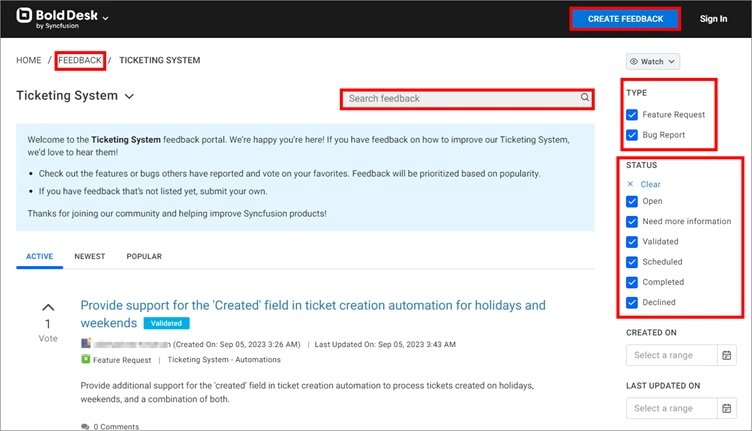
This proactive approach reassures customers that their concerns matter and builds a lasting relationship based on trust and empathy.
According to Brevet, about 80% of deals are sealed only after making at least five follow-up calls post-meeting.
Empathy statements in customer service
Empathy phrases in customer service are sentences that agents use to demonstrate understanding, compassion, and concern for customers’ problems or situations. Here are some empathetic statements in customer service:
Apologizing sincerely
These empathy statements relays how agents genuinely express their regret for a mistake or inconvenience caused.
Examples are:
- I’m genuinely sorry that you’re dealing with this issue. Let’s figure out a solution together.
- I’m truly sorry for the discomfort you’re experiencing. We’ll do our best to fix this.
- I feel terrible about the inconvenience you’ve faced. Let’s work together to solve this.
- I’m really sorry you’re dealing with this. Let’s figure out a solution.
Assuring customers
These statements unveils how agents re-builds customers confidence by making them understand that their issue is being addressed and a solution is being sought.
Examples are:
- I understand your concerns and assure you we’re working relentlessly to fix this.
- Your patience is greatly appreciated. I assure you we’re doing everything we can to solve this.
- I value your understanding. We’re doing our best to sort this out swiftly.
- Thank you for your patience and understanding. I assure you we’re diligently working on this.
Validating customers’ feelings
These statements show an empathetic view of how agents recognize and acknowledge customers emotions and reactions to a scenario.
Examples are:
- I see why this situation is disheartening for you. We’re here to back you up.
- I understand why you’d be upset by this. We’re determined to make it right.
- I see why this could be frustrating for you. We’re here to help you through it.
- I understand why this could be worrying for you. Don’t worry, we’ve got your back.
Commitment to customers issues
These statements show how agents are heartedly committed to customers issues is showing dedication in resolving their problem in a satisfactory way.
Examples are:
- I realize how serious this is for you. . We’re determined to find a solution that works for you.
- I understand why this is important to you. We’re dedicated to solving this in a way that works for you.
- I understand how crucial this is for you. We’re committed to making things right.
- I see how vital this is for you. We’re devoted to finding a solution that fits your needs.
Understanding customers’ feeling
Understanding customers feelings are statements that define how agents empathize with the emotions customers are experiencing due to their current situation.
Examples are:
- I understand how distressing this must be. We’re here to help you.
- I see how this could upset you. We’re working hard to address your concern.
- I realize the stress this situation must be causing. We’re determined to resolve your concern swiftly.
- I understand how challenging this must be for you. Don’t worry, we’re here to support you.
Recognizing customers’ disappointment
These types of empathy statements show how agents acknowledge customer’s negative feelings due to unsatisfactory service or unmet expectations.
Examples are:
- I acknowledge your disappointment. We’re committed to improving our service.
- I understand your dissatisfaction with our service. We promise to do better in the future.
- I see how let down you must feel. We assure you that we’ll strive to improve.
- I acknowledge your displeasure with our service. We’re committed to making necessary improvements.
Valuing customers’ feedback
These types of empathy statements show appreciating their input and using it to make necessary improvements.
Examples are:
- I understand that this experience may not have been what you expected. We value your feedback and will use it constructively.
- I see how this situation might have been unsatisfactory for you. Your feedback is invaluable to us for making improvements.
- I realize this experience may have fallen short of your expectations. Your feedback is extremely important to us for improving our service.
- I understand your disappointment. Your feedback is precious to us and will help us improve our service quality.
Adopt empathy phrases in customer service today!
In conclusion, gauging empathy in customer service is vital to ensuring that your customer lifetime value increases and beats the competitive market.
Try using BoldDesk®, a powerful help desk software that solves all your customer service problems. You can also arrange a 30-minute live demo to have a live experience. Additionally, you can begin a 15-day free trial to discover how BoldDesk’s features can be customized to meet your firm’s needs. To learn more and find out how to get started with BoldDesk, please contact BoldDesk support team.
We’d love to hear your thoughts! Share your experiences or insights on empathy in customer service in the comments below.
Related articles


















 Email Ticketing System
Email Ticketing System Shared Inbox Software
Shared Inbox Software Multi Brand Help Desk
Multi Brand Help Desk Internal Help Desk Software
Internal Help Desk Software Trouble Ticketing Software
Trouble Ticketing Software Mobile Help Desk
Mobile Help Desk 










